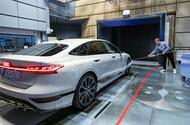# Unveiling the Secrets of Audi’s Most Aerodynamic Car: The A6 E-tron

## The Importance of Aerodynamics in Automotive Design
When it comes to automotive performance, aerodynamics is a crucial yet often overlooked factor. It significantly influences the energy required to propel a vehicle forward. In simple terms, as a car accelerates, the drag force it encounters increases exponentially. For instance, if a car’s speed doubles from 40 mph to 80 mph, the drag force doesn’t just double; it quadruples, leading to higher fuel or electricity consumption.
## Balancing Aesthetics and Efficiency
Creating a car that minimizes drag isn’t merely about making it look sleek. Designers and aerodynamics engineers must collaborate to strike a balance between visual appeal and functional efficiency. This intricate dance of design and engineering has a long history, with Audi being a pioneer in the field.
## Audi’s Legacy of Aerodynamic Innovation
In 1983, Audi made waves in the automotive world with the introduction of the Audi 100, which boasted a drag coefficient (Cd) of just 0.30—an unprecedented achievement for production cars at the time. Fast forward to today, and Audi has once again set the bar high with the launch of the A6 Sportback E-tron, which features an impressive Cd of 0.21, making it the most aerodynamic Audi to date.
## The Engineering Process Behind the A6 E-tron
So, how did Audi achieve this remarkable aerodynamic feat? The process began with the design team presenting their initial concepts, which were then subjected to rigorous testing. The aerodynamics team conducted around 1,300 simulations and spent countless hours refining physical models in a wind tunnel. This meticulous process allowed them to resolve discrepancies in design details that could impact airflow.
### Key Design Adjustments
One notable adjustment involved the air curtain intake, which initially protruded more than ideal. By fine-tuning this feature, the team ensured that it would not disrupt airflow. Additionally, the ‘switchblade’ cool air intake below the front grille was optimized to enhance aerodynamic performance further.

### Enhancing the Underbody and Wheel Design
The underbody of the A6 E-tron plays a vital role in its aerodynamic efficiency. The design team focused on creating a smooth undertray, which included a large radius on the air outlet and extensive coverage of the sills and rear axle. This attention to detail minimizes turbulence and enhances airflow.
Wheel design was another critical area of focus. The rims were crafted to be flat, allowing air to flow smoothly across their surface. Audi introduced 21-inch wheels with aerodynamic blades made from lightweight plastic, alongside 19-inch and 20-inch options, all designed to maintain aesthetic appeal while maximizing performance.
## Achieving the Perfect Aerodynamic Shape
The overall shape of the A6 E-tron, including its rear height and contours, significantly impacts both its drag coefficient and lift generation. Audi’s engineering team meticulously fine-tuned these elements to achieve an optimal balance, resulting in a record-breaking aerodynamic profile.
## Conclusion
The Audi A6 E-tron exemplifies the brand’s commitment to innovation and excellence in automotive design. By prioritizing aerodynamics, Audi has not only enhanced the vehicle’s performance but also set new standards for efficiency in electric vehicles. As the automotive industry continues to evolve, Audi remains at the forefront, proving that the pursuit of aerodynamic perfection is a journey worth undertaking.